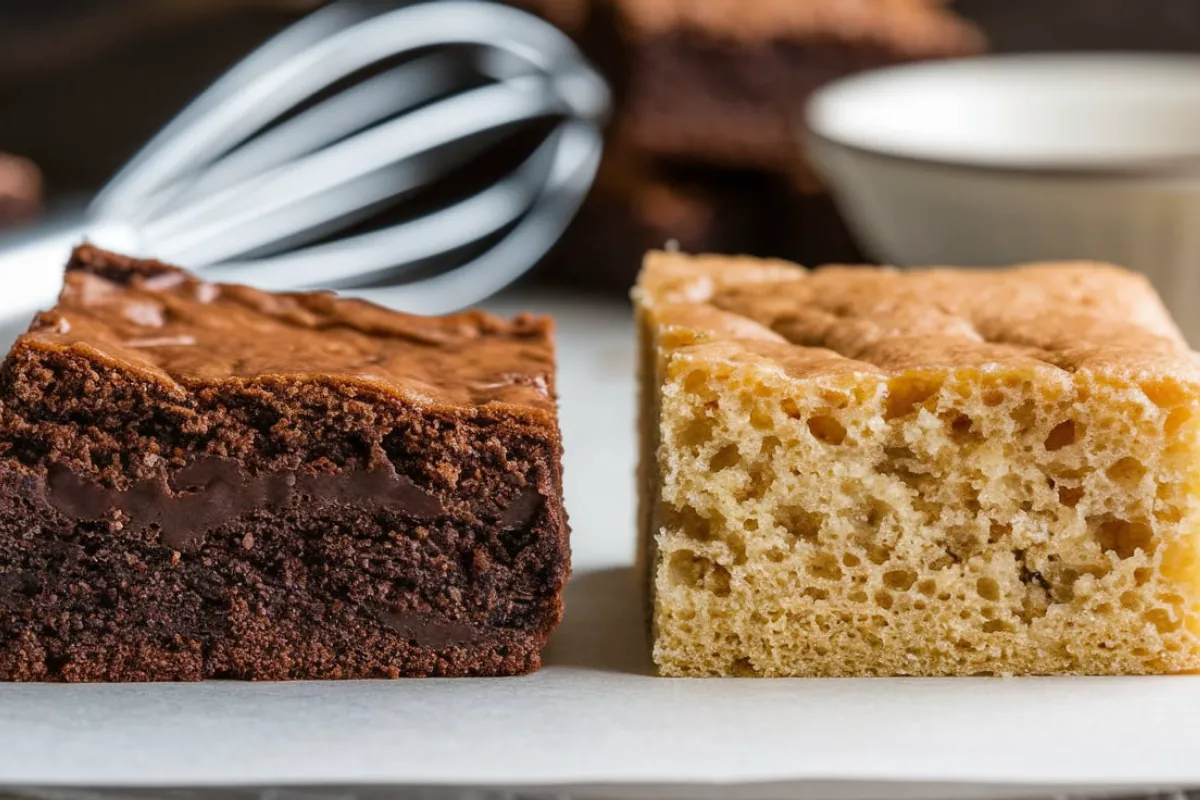Brownies are a classic dessert, but not all brownies are created equal. Some are fudgy and dense, while others are cakey and light. The difference between these two textures boils down to a few key factors: ingredient ratios, baking techniques, and the use of leavening agents. In this article, we’ll explore the science behind what makes a brownie fudgy or cakey and how you can achieve your desired result every time.
Texture Comparison: Fudgy vs. Cakey Brownies
The texture of a brownie is the clearest indicator of whether it’s fudgy or cakey.
- Fudgy Brownies: These brownies are rich, dense, and moist, often with a gooey center. They have a higher fat content, which gives them their signature decadent texture.
- Cakey Brownies: These brownies are light, fluffy, and rise higher during baking. The batter for cakey brownies contains more flour and leavening agents, making them resemble cake more than fudge.
For a more detailed guide on different brownie textures, check out this Brownie Texture Guide, which explains what makes brownies chewy, fudgy, or cakey.
Key Ingredient Differences: Flour, Fat, and Sugar Ratios
The ingredient ratios used in brownie recipes determine whether the final product will be fudgy or cakey.
- Flour: Fudgy brownies have less flour, which helps retain their moisture and dense texture. Cakey brownies, on the other hand, use more flour to help create a lighter and more structured crumb.
- Fat: Butter or oil plays a big role in making brownies fudgy. Recipes with more fat result in a gooier texture. In contrast, cakey brownies contain less fat, making them lighter and fluffier.
- Sugar: The amount of sugar also affects the texture. Fudgy brownies usually have a higher sugar content, which contributes to their moist and chewy consistency.
For more inspiration, try this Ultimate Banana Brownie Recipe, which combines a unique flavor with a perfect fudgy texture.
The Role of Eggs and Leavening Agents
Eggs and leavening agents like baking powder or baking soda can drastically change the texture of your brownies.
- Eggs: Fewer eggs or using only egg yolks leads to a fudgier texture, while adding more eggs (especially egg whites) makes brownies lighter and more cake-like.
- Leavening Agents: Baking powder or baking soda is typically used in cakey brownie recipes to help the batter rise and create a lighter crumb. Fudgy brownies, however, use little to no leavening agents.
If you’re curious about how these ingredients impact your brownies, read this guide on what makes brownies fudgy or cakey.
Baking Techniques: Time and Temperature Differences
The way you bake your brownies is another factor that influences their texture.
- Fudgy Brownies: Bake them at a lower temperature for a shorter period. This ensures the center remains slightly underbaked, giving them a gooey consistency.
- Cakey Brownies: Bake at a higher temperature for a longer period to achieve a fully set, cake-like texture.
Tips for Customizing Your Brownies: Fudgy vs. Cakey
Want to adjust your brownies to your desired texture? Here’s how:
- For Fudgy Brownies:
- Add more butter or oil.
- Use less flour to keep the batter dense.
- Reduce or eliminate leavening agents like baking powder.
- For Cakey Brownies:
- Increase the flour and add baking powder.
- Use whole eggs or even additional egg whites to introduce air.
- Bake at a higher temperature for a longer period.
For more tips on adjusting brownie recipes, check out this complete guide on what determines brownie texture.
Common Mistakes That Affect Brownie Texture
Small changes can drastically affect how your brownies turn out. Here are some common mistakes to avoid:
- Using too much flour: Even a slight increase in flour can make brownies cakey instead of fudgy.
- Overmixing the batter: Mixing too much incorporates air, making brownies rise more, leading to a lighter, cakey texture.
- Overbaking: Leaving brownies in the oven for too long dries them out, resulting in a cake-like texture instead of a gooey one.
FAQs: Common Questions About Brownie Texture
- Why are my brownies cakey instead of fudgy?
Cakey brownies often result from too much flour or leavening agent. Reducing flour and avoiding baking powder can help create fudgier brownies. - Can I make brownies more fudgy by reducing the flour?
Yes, reducing the flour and increasing the fat content will give you fudgier brownies. - What is the secret to making fudgy brownies?
The key is using more butter or oil, fewer eggs, and baking for a shorter time at a lower temperature. - Do I need to use eggs in brownies to make them fudgy?
Eggs help add moisture and richness. Using fewer eggs or focusing on egg yolks can result in fudgier brownies. - Can brownies be made without baking powder or baking soda?
Yes, fudgy brownies often omit leavening agents to maintain their dense, rich texture.
Conclusion: Fudgy vs. Cakey Brownies
The difference between fudgy and cakey brownies comes down to the balance of ingredients, the baking technique, and the use of leavening agents. By adjusting these factors, you can easily control the texture of your brownies, making them gooey and fudgy or light and airy. Understanding these elements will help you master your brownie game and bake the perfect batch every time.
For more in-depth tips, visit this guide on the science behind fudgy and cakey brownies.

